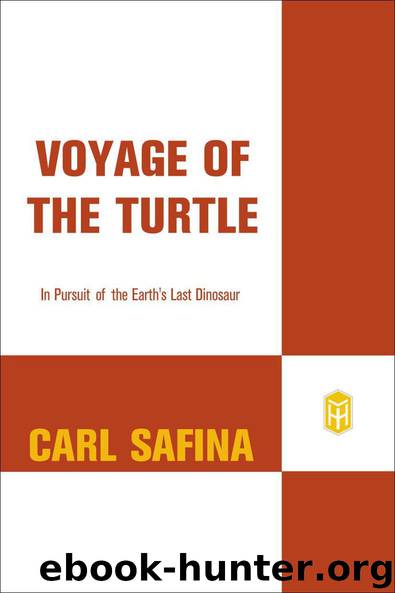Voyage of the Turtle: In Pursuit of the Earth's Last Dinosaur by Carl Safina

Author:Carl Safina [Safina, Carl]
Language: eng
Format: epub, azw3
Publisher: Henry Holt and Co.
Published: 2015-08-20T16:00:00+00:00
WORLDWIDE, FIFTEEN MILLION PEOPLE FISH COMMERCIALLY. THE MOST dangerous occupation, fishing kills workers at rates eighteen to thirty times higher than national averages of on-the-job deaths. The fish they land are worth about $80 billion annually at the dock. But depletion from overfishing marginalizes the profits, and mechanization is reducing employment. Many longline boats operate on thin margins or take losses. The average U.S. Atlantic and Gulf of Mexico longline boat loses $7,000 annually.
Into this picture stroll conservationists, usually pale and plump, asking—nay, often demanding—that fishers use new and unfamiliar gear, rerig their boats, or change their hook styles. Or stop fishing. But shutting down Hawaii-based long-liners would cost sixteen hundred jobs, for instance. So politicians would likely oppose any proposal to eliminate the industry.
The courts offer a different route.
Peaceable though they be, all sea turtles currently pack the punch of the U.S. Endangered Species Act. Whenever a species that goes by the title “endangered” or “threatened” might be affected by an action of the U.S. federal government, the U.S. Fish and Wildlife Service or the National Marine Fisheries Service must issue a “biological opinion” saying whether the activity is likely to “jeopardize the continued existence” of the species. If so, officials are supposed to lay out steps toward eliminating the jeopardy. Solomon in his glory could only have hoped for such wisdom.
But neither the U.S. government nor its citizenry is Solomon, so disputes arise. The game is usually played like this: the government tries to squeeze out the narrowest, rosiest interpretation, while conservation groups try to force a sweeping assessment that takes every problem into account. In the case of Hawaii long-lining, the Fisheries Service issued no fewer than five biological opinions between 1985 and 1998. Each had, shall we say, issues. In 1985 the service considered the fishery out to only two hundred miles, and issued it permission to “take” 50 Loggerheads and 50 Leatherbacks and to kill 25 of each. In the legalese, “take” means, basically, mess with in any way, including catching and releasing. Due to crashing fish populations on the U.S. East and Gulf Coasts, many boats moved to Hawaii in the late 1980s. Their influx prompted another biological opinion. Again the Fisheries Service constricted its geographical view, issuing the industry permission to “take” 25 and kill 1 each of Loggerhead, Leatherback, and Green. When the Fisheries Service finally recognized that the industry was operating over a huge swath of ocean extending hundreds of miles from Hawaii, its 1993 biological opinion determined that the fishery would not “jeopardize the continued existence” of turtles—over the next twelve months. That time restriction is a no-no, but the service was hoping to either buy time or pull a fast one. Its officials were pushing other envelopes, too—they jacked the allowed “take” to 752 turtles, including the mortality of a precise-sounding 299.
Emboldened perhaps by getting away with it, the service’s 1994 biological opinion increased the authorization to 849 turtles annually, including 129 lethal “takes.” In 1996 sea turtle specialists
Download
Voyage of the Turtle: In Pursuit of the Earth's Last Dinosaur by Carl Safina.azw3
This site does not store any files on its server. We only index and link to content provided by other sites. Please contact the content providers to delete copyright contents if any and email us, we'll remove relevant links or contents immediately.
The Lonely City by Olivia Laing(4750)
Animal Frequency by Melissa Alvarez(4395)
All Creatures Great and Small by James Herriot(4232)
Walking by Henry David Thoreau(3893)
Exit West by Mohsin Hamid(3777)
Origin Story: A Big History of Everything by David Christian(3648)
COSMOS by Carl Sagan(3554)
How to Read Water: Clues and Patterns from Puddles to the Sea (Natural Navigation) by Tristan Gooley(3406)
Hedgerow by John Wright(3275)
The Inner Life of Animals by Peter Wohlleben(3259)
How to Read Nature by Tristan Gooley(3249)
How to Do Nothing by Jenny Odell(3232)
Project Animal Farm: An Accidental Journey into the Secret World of Farming and the Truth About Our Food by Sonia Faruqi(3177)
Origin Story by David Christian(3147)
Water by Ian Miller(3127)
A Forest Journey by John Perlin(3027)
The Plant Messiah by Carlos Magdalena(2883)
A Wilder Time by William E. Glassley(2818)
Forests: A Very Short Introduction by Jaboury Ghazoul(2790)
